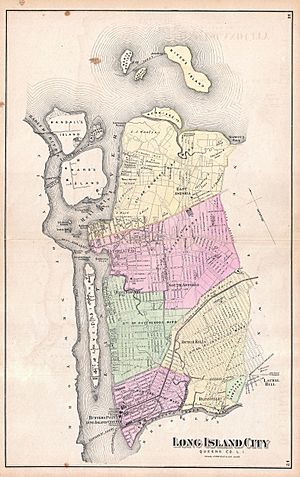Sunswick Creek facts for kids
Sunswick Creek was a small stream that used to flow through the neighborhoods of Astoria and Long Island City in Queens, New York City. Today, it flows underground, hidden from view. The creek started near the Queensboro Bridge and Queens Plaza in Long Island City. It then flowed north towards where the Socrates Sculpture Park is now in Astoria, finally emptying into the East River. The name "Sunswick" comes from an old Algonquin language word. It probably means "Woman Chief" or "Sachem’s Wife."
In the late 1600s, a settler named William Hallet built a milldam at the creek's mouth. This created a pond that helped power a mill. As Long Island City grew and became more industrial, the creek got very dirty. Because of this, people started covering it up in the late 1800s.
Contents
Where Did Sunswick Creek Flow?
Before it was covered, Sunswick Creek began near 21st Street. This was north of what we now call the Queensboro Bridge and Queens Plaza. This area was part of Ravenswood, a section of Long Island City. The creek flowed north, passing close to where the Queensbridge Houses and the Ravenswood Generating Station are today. It generally followed the path of present-day 21st Street.
A large city block, where Long Island City High School now stands, shows where the creek used to flow above ground. Sunswick Creek emptied into the East River near the Socrates Sculpture Park in Astoria.
What Does "Sunswick" Mean?
The name "Sunswick" was once used for the neighborhoods around the creek, including parts of Ravenswood and Astoria. Experts believe the name came from a Native American language, possibly the Algonquin word "Sunkisq." The Greater Astoria Historical Society suggests it means "Woman Chief" or "Sachem’s Wife."
You can still see the name "Sunswick" today. For example, there's a bar called Sunswick 3535 at 35th Street and 35th Avenue. Also, what is now 22nd Street used to be called Sunswick Street.
The History of Sunswick Creek
Early Settlement and Pollution
In 1664, a British settler named William Hallet bought land on the northern side of the creek's mouth. He bought this land from two Native American chiefs. This area, which stuck out into Hell Gate, was later named Hallet's Cove. Hallet also built a lime kiln near the creek.
Sunswick Creek was an important waterway. It connected with Dutch Kills, another stream to the south. This made it easy for traders to move farm products and other goods. In 1679, a milldam was built at the creek's mouth, creating a small pond. Later, in 1753, Joseph Hallett and Jacob Blackwell built a mill on the creek's right bank.
By the 1860s and 1870s, Sunswick Creek became very polluted. This was because of more factories, a lack of good sewer systems, and many people living in Long Island City and Astoria. Diseases became common around the creek by 1866. The damming of the creek stopped the natural flow of salt water. This made the water still and slimy, leading to many mosquitoes.
After disease outbreaks in 1871 and 1875, the marshy areas around the creek were drained in 1879. Long Island City also started building a proper sewer system in the 1870s. The creek was partly sent into one of these new sewer tunnels around 1893.
The 20th Century: Covering the Creek
After Queens became part of City of Greater New York in 1898, the low-lying area north of the present-day Queensboro Bridge, called Sunswick Meadows, was filled in. This happened during the construction of the bridge in the early 1900s. Dirt from digging New York City Subway tunnels in Manhattan was used to fill the land. Street cleaners also threw dry trash into the area to raise the ground level of nearby streets.
In 1915, people living in Ravenswood complained about the tide gates on Sunswick Creek. These gates were put in to help with mosquitoes. However, residents said the gates were actually trapping mosquitoes by making the water stagnant. They even threatened to open the gates themselves. The city suggested filling in their land, which would have cost a lot of money.
In April 1916, residents broke down the barriers with axes. The health commissioner said the residents "prefer to live like hogs," which made people angry. After this, the Queens borough president planned to install two new tide gates.
By the end of 1916, the New York City government decided to close up Sunswick Creek completely. They told nearby homes to send their sewage elsewhere. By 1920, most of the creek's former path had been built over with factories. In 1957, during digging for a sewer line, workers found parts of the old mill at the creek's mouth.
Sunswick Creek Today
Today, Sunswick Creek flows underground as part of a sewage tunnel system. An urban explorer named Steven Duncan has even documented it online. Some people say that during heavy rains, you can still hear the creek near the Sohmer and Company Piano Factory, across from Socrates Sculpture Park.
In 2011 and 2012, the Socrates Sculpture Park and Noguchi Museum worked with artist Mary Miss. She created an art project called Ravenswood/CaLL. It included signs and mirrors placed along the path where the creek used to flow.
Images for kids



